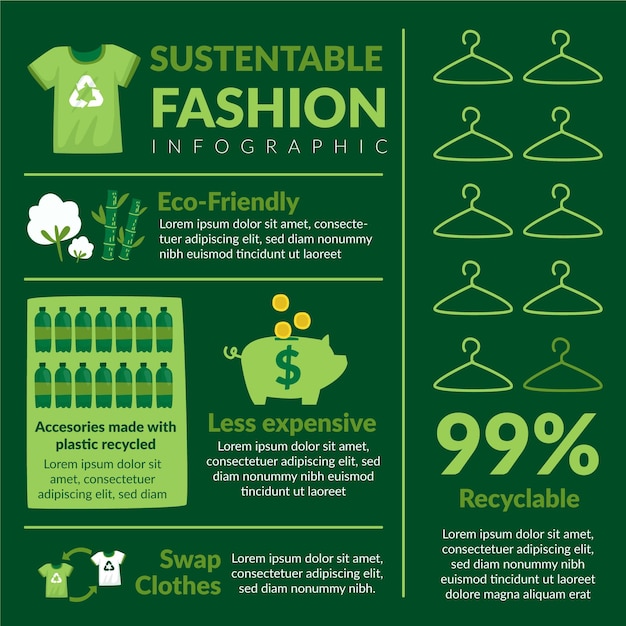Cape Town Sustainable Fashion: Environmentally Friendly Trends to View
Cape Town Sustainable Fashion: Environmentally Friendly Trends to View
Blog Article
Keep Ahead of the Contour by Discovering Innovative Fashion Trends
In a market as vibrant as style, staying in advance involves greater than simply adhering to current fads-- it requires an expedition of innovation. Smart textiles, as an example, are transforming garments into useful masterpieces, while 3D printing is transforming style processes with its adjustable, waste-reducing abilities. As sustainability becomes a keystone, innovations like green products and round style methods are reshaping environmental obligation - Cape Town Sustainable Fashion. Additionally, the merging of modern technology and style heralds a brand-new age of consumer interaction. Just how, after that, can these emerging patterns redefine the future of fashion, and what ramifications do they hold for brands looking for to thrive in this developing landscape?

Welcoming Smart Textiles
In the last few years, the apparel industry has experienced a transformative change with the integration of wise fabrics, an advanced advancement that mixes modern technology with fabric. This development represents not just a fusion of looks and functionality yet also a significant leap in the direction of sustainability and customization in style. Smart textiles, likewise understood as e-textiles, installed advanced electronics such as sensors and conductive threads within the fabric, enabling garments to communicate with the setting or the wearer.
These fabrics are made to keep track of physiological specifications, such as heart rate or body temperature, offering real-time health analytics. Beyond health and wellness applications, smart textiles are also being made use of for flexible apparel, which can change shade or pattern in action to ecological stimuli, hence supplying a vibrant style experience.
Additionally, the advancement of energy-harvesting textiles that produce power from activity or sunshine is leading the means for self-sufficient wearable technology. This technology is interesting eco conscious consumers and designers intending to minimize the eco-friendly impact of fashion. As research study and development in this area advancement, smart textiles are anticipated to become significantly widespread, reshaping the landscape of modern-day fashion with their multifunctional abilities.
The Surge of 3D Printing
Reinventing the manufacturing landscape, 3D printing has actually arised as a game-changer in the apparel industry. This innovative modern technology has made it possible for developers to press the boundaries of creative thinking, creating complex and customized garments that were formerly unthinkable. By leveraging electronic design and additive production, 3D printing facilitates the creation of intricate geometries and patterns, allowing developers to explore new structures and frameworks.
A significant advantage of 3D printing in fashion is its capacity to create on-demand, minimizing waste and decreasing stock needs. This effectiveness not just maximizes manufacturing procedures but also allows for rapid prototyping, allowing developers to bring their visions to life in a shorter duration. Additionally, 3D printing sustains modification somewhat unequaled by conventional methods, using unique styles and personalized fits tailored to individual consumer choices.
The rise of 3D printing has also equalized fashion, making it available to arising designers who can now make premium items without substantial financial investment in traditional manufacturing infrastructure. As modern technology continues to development, the garment industry is positioned to harness the full potential of 3D printing, exploring new products and methods that will undoubtedly redefine just how fashion is developed and produced.
Sustainable Fashion Innovations
As the fashion business grapples with journalism demand for environmental duty, sustainable fashion developments have emerged at the forefront of transformative adjustment. The growing understanding of eco-friendly influence has actually fueled a change in the direction of more eco-conscious methods and products. Brands and designers are currently focusing on sustainability, including approaches that reduce waste and reduce carbon footprints.
One significant advancement is the rise of round fashion, which stresses recycling and upcycling to prolong the lifecycle of garments. This approach not just minimizes waste however also motivates consumers to embrace a much more mindful method to clothes usage.
One more breakthrough hinges on the adoption of cutting-edge dyeing methods that use all-natural dyes or waterless procedures, consequently decreasing the large amounts of water and chemicals typically made use of in textile dyeing. Furthermore, advancements in biotechnology have brought about the production of lab-grown leather and materials, providing eco pleasant and cruelty-free options to traditional materials. With these pioneering efforts, the garment industry is making purposeful strides in the direction of a much more sustainable future.

Tech-Integrated Apparel
Tech-integrated clothing stands for an innovative combination of style and technology, improving just how individuals communicate with their apparel. This innovative domain is noted by the incorporation of smart textiles and ingrained digital elements, improving both capability and aesthetic appeal. From physical fitness trackers installed in sports apparel to heated jackets controlled by means of smart device applications, tech-integrated apparel provides consumers unmatched comfort and flexibility.
Pioneering brand names are driving this trend, focusing on developing garments that react to ecological stimulations or customer commands. For instance, some garments can transform shade or pattern in action to temperature changes, while others incorporate biometric sensors to check wellness metrics like heart rate or tension levels. The smooth combination of innovation into textiles additionally encompasses ecological sustainability, with initiatives to establish self-cleaning textiles or garments that get used to climate condition, therefore lessening the check these guys out requirement for numerous layers.
Additionally, the arrival of wearable technology is not simply restricted to clothing however includes accessories like watches and eyewear, additional widening the scope of tech-integrated style. As the industry continues to innovate, the possibility for modification and personalization in garments expands, providing customers special, tech-enhanced style experiences that accommodate their private demands and preferences.
Future of Virtual Style
Recently, the future of digital style has become a transformative pressure within the sector, leveraging advancements in digital innovation to redefine exactly how style is created, experienced, and taken in. By integrating enhanced fact (AR), online reality (VR), and 3D layout devices, developers can now craft immersive and interactive experiences that go beyond standard fashion borders. Online style permits for the creation of garments that exist solely in digital environments, supplying countless possibilities for advancement without the constraints of physical production.
This digital shift not only presents possibilities for innovative expression but also addresses sustainability concerns integral in traditional style methods. Cape Town Sustainable Fashion. By getting rid of the demand for physical sources, online fashion reduces waste and lessens carbon impacts. Furthermore, the surge of digital style lines up with the boosting customer demand for tailored and unique experiences, as online garments can be customized and customized to individual choices easily

Conclusion
The garment industry's reference future hinge on the combination of sustainable techniques and ingenious technologies - Cape Town Sustainable Fashion. Smart textiles and tech-integrated clothing are improving capability, while 3D printing offers chances for personalization and waste reduction. Lasting fashion, via eco-friendly products and circular techniques, demonstrates a dedication to environmental stewardship. In addition, online fashion is poised to redefine consumer interactions. Adapting to these patterns is vital for brands looking for to stay affordable and pertinent in this swiftly developing landscape.
In current years, the style market has experienced a transformative change with the combination of clever textiles, an advanced development that blends innovation with material.As the style industry grapples with the pushing requirement for ecological responsibility, lasting fashion innovations have actually arised at the forefront of transformative modification.In current years, the future of virtual fashion has emerged as a transformative pressure within the industry, leveraging advancements in digital technology to redefine how fashion is developed, experienced, and taken in. The increase of online fashion aligns with the boosting consumer demand for special and individualized experiences, as virtual garments can be customized and tailored to individual preferences with convenience.
The style market's future lies in the integration of lasting practices and ingenious Source technologies.
Report this page